Steel radiator type 11: operational features and differences
Currently on sale is a wide range of heating steel batteries. These products are distinguished by dimensions, configuration, power parameters, wiring diagram, color, price and other characteristics.
Among the wide range of these devices, panel batteries of the eleventh type are of particular interest. The relevance of these devices is explained by the excellent appearance, compact dimensions, acceptable power indicators and of course an affordable price.
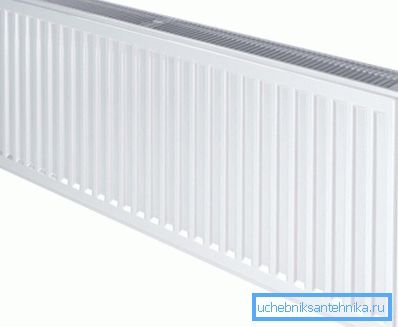
In this article we will look at the technical and operational characteristics of this equipment, and also compare these parameters with those of other batteries.
Design features
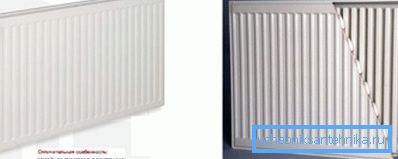
The steel panel radiator type 11 is a single-row heating equipment, equipped with one convector, which is welded to the back side of the panel. The number 11 in the label stands for one panel and one convector.
Due to the design features, the front side has the dimensions of a full-fledged heater, while the thickness of the device is only 47-50 mm. Design features predetermined scope of such devices. These heaters are used both for their intended purpose and as decorative elements of the entourage.
Agree that flat neat panels can make the interior more stylish.
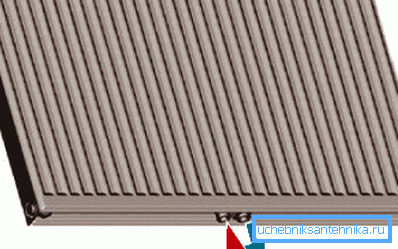
An important characteristic that should be considered when choosing batteries is the center distance, that is, the gap between the upper and lower side opening. In the assortment of eleventh type heaters, there are models with 700, 600, 500 and 300 mm. The length can pick up the battery from 40 cm to 3 meters.
Most batteries of this type are sold with a standard arrangement of technological holes, namely, 2 above and 2 below. There are modifications designed specifically for connection to the lower liner of pipes. Such modifications are quite popular in the design of modern apartments and country houses, where pipes are supplied hidden under the floor.
Operational features
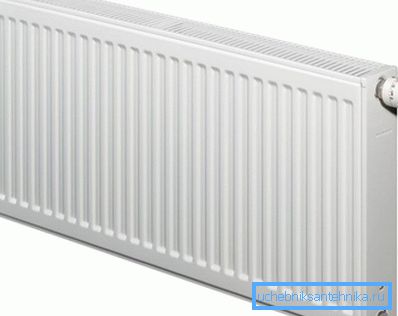
Among the advantages of panel radiators of the eleventh type, the following should be noted:
- Attractive from an aesthetic point of view due to the integrity of the design. A solid plate with stylish stamping on the front side looks much more modern and neater compared to archaic sectional heaters. That is why many domestic designers for interior design in high-tech stela are trying to use these devices.
- Efficiency, as these batteries quickly heat the air in the room, with the result that the autonomous heating system works in an economical mode.
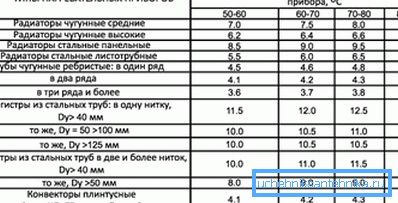
The device is characterized by high heat transfer, which is partly due to the presence of a convector. In addition, steel heats up faster than cast iron.
Important: In order for these radiators to fully demonstrate their energy efficiency, the system must be equipped with a thermostat that will turn the boiler on and off when necessary.
- Simplicity and ease of maintenance, as the front panel is easy to clean up from dirt. The fact is that the surface of panel batteries has a special protective lacquer glossy coating. In order to erase even dried dirt, it is enough to wipe the surface with a damp cloth and this will be enough.
- Simple installation instructions, due to the fact that the purchased device is almost ready for installation with your own hands. The radiator is a single panel, which, unlike sectional counterparts, does not need to be disassembled or extended. In order to make the installation successfully, it is enough to purchase a universal kit containing brackets, two pass-through plugs and two plugs.
- Low weight and, as a consequence, the possibility of installation on various surfaces. Let's say you decided to build a heating system not in a new apartment or in a modern cottage, but in a typical Khrushchev, where the density of the walls is not too high. It is not recommended to put heavy radiators on loose surfaces, as their weight is high. But a light panel battery in such cases is the optimal choice, since it will not exert excessive load on the wall.
Important: Due to the small weight of such heating devices are commonly used in the arrangement of frame houses and log cabins.
The main differences of the eleventh radiator from panel analogs of the 22 and 33 types

There are few differences between the listed modifications, but they are, and they are significant.
In accordance with generally accepted international standards, the first digit in the marking of steel batteries indicates the number of panels used in the design. Thus, in the eleventh type, this is one panel, while type 22 is two panels and, accordingly, type 33 is three panels.
The second difference is the second digit, which indicates the number of convectors used.
The convector, in this case, is a tubular coil that is either welded to the panel or enclosed between two closely spaced panels. It is easy to understand that the eleventh type is equipped with one coil, whereas in type 22 there are two coils, and in type 33 there are three coils.

In theory, the more convectors, the better, since the heated air will circulate faster within the heated room. On the other hand, the dimensions of the convector and its efficiency should correspond to the dimensions of the main panel. In devices of the eleventh type, this combination is acceptable and the presence of one convector is more than enough with a device thickness of not more than 5 cm.
By the way, along with the listed modifications, there are devices of the 20th type. In these constructions only heating panels without a convector are used. Of course, such batteries significantly lose the eleventh type in terms of energy efficiency. But equipment without an integrated convector has an important advantage, namely, it accumulates less dust.
Conclusion
So, we have considered the main characteristics of the heating device, which you can use when arranging an apartment or a country house. More useful information can be found by watching the video in this article.